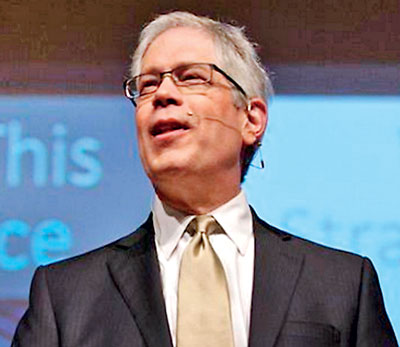Sunday Mar 16, 2025
Sunday Mar 16, 2025
Thursday, 3 August 2017 02:09 - - {{hitsCtrl.values.hits}}
 By Mark Chussil
By Mark Chussil
Never before have there been so many well-educated, highly motivated, professional managers. We tap business intelligence, competitive intelligence, and market intelligence. We mine data unprecedented in breadth, timeliness, quality, and quantity. We use sophisticated techniques to target customers, optimise operations, and manage capital. We work in a society that rewards us well when we achieve our goals.
So why, with all our skills, data, enthusiasm, opportunities, knowledge, motivation, and power, do we produce intelligent failures? By “failure” I don’t mean the spectacular crashes that make the front pages, and I specifically don’t mean those due to chicanery. I mean the invisible failures behind the targets we don’t hit, the promotions we don’t get, the market shares we don’t hold, and the profits we don’t earn.
These failures are unremarkable because they are common. That they are common, though, does not make them any less painful or disappointing. The 1975 Fortune 500 lists huge, respected corporations such as Esmark, Gulf & Western, Polaroid, and Singer that have essentially vanished. They didn’t vanish overnight and they didn’t vanish voluntarily.
Even some survivors from 1975 are studies in falling short rather than flying high. Sears, Roebuck was founded in 1893 and moved into the Sears Tower in 1973, when Wal-Mart was a corporate toddler. Today, Wal-Mart is five times the size of Sears, and Sears has left the building.
We hear plenty of explanations. The tough economy, short-sighted management, finicky customers, strait-jacket regulations, unforgiving Wall Street, slimy corporate politics, stingy corporate budgets. We even give some of the explanations catchy names, such as “hypercompetition,” that suggest the world has changed in some fundamental way.
Saying that we have shifted to a world of hypercompetition is like saying that the force of gravity has grown because a jet aircraft can hit the ground faster than a turboprop. Yes, fortunes are won and lost with stunning speed, and some involve breathtaking numbers. However, the underlying causes are not new, although the effects are louder and more visible in today’s hypermedia.
No one intends to make bad strategy decisions. At our core we are responsible managers, concerned citizens, and thoughtful human beings. To create smart strategies, we don’t need to exhort ourselves to “do better;” we already want to do better. Rather, we must understand what leads well-equipped, well-educated, well-intentioned strategists to choose bad strategies.
Good strategy decisions
Why do upstarts beat incumbents? It happens so often it seems obvious that they should. Yet it is the incumbents, not the upstarts, who usually have (at least on paper) overwhelming advantages.
They have experience, infrastructure, capital, relationships, brands, and economies of scale, data, and more. The defeat of an incumbent by upstarts is usually an intelligent failure. The subsequent transformation of an upstart into an incumbent — all incumbents were upstarts at one time — is another.

Interestingly, incumbents’ advantages over upstarts usually include having much more of precisely what strategists would say are required for good strategy decisions. What’s needed for a good strategy decision? Based on what I’ve heard strategists say, I suspect most strategists’ wish-lists would include items like these:
nAccurate, timely data about the past and present.
nExpert forecasts about the future of the market and competition.
nEnough time to analyse those data thoroughly.
So, if upstarts have less of those things than incumbents do, does that mean they’re making bad strategy decisions? I don’t think so, and I doubt that incumbents would think they’d improve their strategy decisions by ignoring their data, forecasts, and tools. Instead, let’s tackle a subtly different question. What’s needed for a person to make a good strategy decision? My nominations:
nGood decision-making tools.
nGood decision-making attitudes.
nA compensation system that rewards good strategy decisions.
In my experience facilitating and observing better strategy decisions with dozens of Fortune 500 companies, I’ve found that strategists often believe, at first, that they’ll get better strategy decisions by focusing on better analysis of better data; that is, by focusing on the first list. I’ve learned, however, that the greater opportunity is in the second list.
The two lists are qualitatively different. In that difference is a critical point: better strategy decisions won’t come from more of the numbers we’ve already got in vast abundance. (Ask your local market researcher to show you his or her library.) It’s a rare strategy failure that would have been prevented by an extra decimal point. Better strategy decisions come from a qualitative shift in how we use numbers, how we generate strategy ideas, and how we align individuals’ and corporate goals. Upstarts often do have advantages there.
The wrong model
Garbage in, garbage out. People often think that what makes a model wrong is inaccuracy in the data fed into it. I suggest that what can also make a model wrong is the structure of the model.
Astronomers devised increasingly complex calculations to reconcile the actual motion of the sun as it orbited the earth with their models’ predictions. Of course, they couldn’t refine their geocentric model enough to make it work. It was the wrong model to begin with.
We hit the same problem when we use models based on trend lines or financial accounting to make strategy decisions. We pour intelligence into them, yet they still fail. They fail because they’re the wrong model to begin with.
VisiCalc was the first electronic spreadsheet. Its sales grew rapidly, and you could create a trend line to project its future sales. Then Lotus 1-2-3 entered the market, and VisiCalc’s trend line didn’t fit any more. You could create a trend line for 1-2-3’s future sales and it would probably fit pretty well… until Microsoft Excel wiped it out.
Trend lines do not cause things; they describe things (specifically, how things correlate with time). Projecting future results with a trend-line model makes a critical, and usually invisible, assumption: the conditions of the past will persist into the future. That’s the wrong model for strategy decisions.
According to financial statements, nothing much happened on the days Jack Welch left GE or Steve Jobs returned to Apple. Why? Because there’s no entry on an income statement or balance sheet for “departure or return of visionary leader.”
Nothing much happened at Microsoft on the day it released its first version of Windows, to Sony on the day the first VHS machine confronted BetaMax, or to Kodak on the day digital cameras hit the market. There are no entries on the financial statements for product innovation, new competition, or declining market. Of course the effects of those events all eventually were manifest on the financials; however, the precipitating causes were, and still are, financially invisible.
Trend lines and accounting formulas simply weren’t designed to model profits, market shares, competition, and customers in the future. The only reason it appears that they can forecast the future is that many strategy decisions are incremental in nature, which seems to validate their predictions.
When there is change in a market — or when a competitor does something unexpected (unexpected because conventional tools tend to hide competitors’ moves, not highlight them) — their logic breaks down, and we have an intelligent failure. In other words, our most common tools (seem to) work when nothing much is going on, and break down just when we need them most.
(Learn more on business and business competition at the Business War Games workshop conducted by PwC’s Academy and Mark Chussil. Mark Chussil is a world expert in war-gaming and strategy simulation and is the Founder of Advanced Competitive Strategies, Inc. Adjunct Instructor at the Pamplin School of Business and the University of Portland. He has helped Fortune 500 companies around the world to add billions of dollars to their bottom lines. For more info contact 0117719874 or [email protected].)
Discover Kapruka, the leading online shopping platform in Sri Lanka, where you can conveniently send Gifts and Flowers to your loved ones for any event including Valentine ’s Day. Explore a wide range of popular Shopping Categories on Kapruka, including Toys, Groceries, Electronics, Birthday Cakes, Fruits, Chocolates, Flower Bouquets, Clothing, Watches, Lingerie, Gift Sets and Jewellery. Also if you’re interested in selling with Kapruka, Partner Central by Kapruka is the best solution to start with. Moreover, through Kapruka Global Shop, you can also enjoy the convenience of purchasing products from renowned platforms like Amazon and eBay and have them delivered to Sri Lanka.
Discover Kapruka, the leading online shopping platform in Sri Lanka, where you can conveniently send Gifts and Flowers to your loved ones for any event including Valentine ’s Day. Explore a wide range of popular Shopping Categories on Kapruka, including Toys, Groceries, Electronics, Birthday Cakes, Fruits, Chocolates, Flower Bouquets, Clothing, Watches, Lingerie, Gift Sets and Jewellery. Also if you’re interested in selling with Kapruka, Partner Central by Kapruka is the best solution to start with. Moreover, through Kapruka Global Shop, you can also enjoy the convenience of purchasing products from renowned platforms like Amazon and eBay and have them delivered to Sri Lanka.